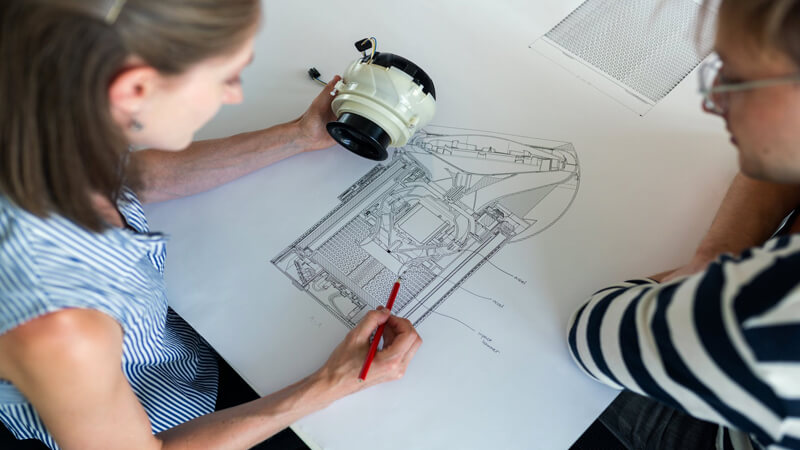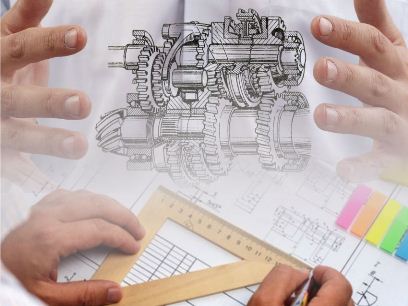Design Engineer PMS:
Design Engineer – PMS in the IT-ITeS Industry is also known as Plant Engineer

Brief Job Description: Engineers in this job are responsible for executing manufacturing engineering tasks in the pre-production, production and post-production phases. They guide the product design team with producibility studies to meet the functional objectives and requirements of the users/customers. They are responsible for manufacturing and other process modeling, Digital Factory – Plant & Facility Layout, CNC Programming, Tooling & Equipment design, Jigs & Fixtures, Gages Design, Quality Assurance, Building Quality Process, Product Costing, Visual Work Instructions, Cost Reduction, etc.
Personal Attributes: This job requires the individual to collaborate with multiple stakeholders and at the same time be comfortable in making independent decisions pertaining to his/her area of work. The individual should have an analytical bent of mind, effective communication skills, strong multi-tasking skills, organizational skills and should demonstrate logical thinking. The individual should possess good problem solving abilities.
Optimize manufacturing processes using software tools:
Performance Criteria
To be competent, you must be able to:
PC1. establish the nature and scope of manufacturing processes to be optimized
PC2. obtain sufficient data/information to accurately simulate existing manufacturing processes and boundary conditions
PC3. input required data/information into appropriate software tools
PC4. simulate different scenarios as per customer requirements
PC5. report the results of simulations to appropriate people using standard templates
PC6. contribute to the analysis of results of simulations, as required
PC7. contribute to presentation of recommendations to optimize manufacturing processes, as required
PC8. obtain advice and guidance from appropriate people, where required
PC9. comply with your organization’s policies, standards, procedures and guidelines when using software tools to optimize manufacturing processes
PC10. identify bottlenecks and understand techniques to mitigate bottlenecks Knowledge and Understanding (K) A. Organizational Context (Knowledge of the company/ organization and its processes) You need to know and understand: KA1. your organization’s policies, procedures and processes for optimizing manufacturing processes using software tools and your role and responsibilities in relation to this KA2. objectives and scope of the work and the importance of keeping within these boundaries KA3. different types of software tools/ engineering drawings used for optimizing manufacturing processes and how to use and update these KA4. the purpose and importance of boundary conditions KA5. standard templates and tools available and how and when to use these KA6. how to record and present the results of simulations and recommendations KA7. how and where to report feedback KA8. who you may need to contact for advice and guidance and to refer problems that fall outside the limits of your authority B. Technical Knowledge You need to know and understand: KB1. actual manufacturing process & production technology from an industry specific perspective KB2. output with regards to fundamentals KB3. engineering drawings & interpretation of GD&T symbols KB4. different sources of information and methodologies available for carrying out optimization tests and how to access these KB5. how to carry out simulations and the importance of doing this correctly KB6. different types of simulations and how to select and run these KB7. problems that can occur when running simulations and how to address these KB8. how to analyze and interpret simulations and the purpose of doing this KB9. current practice for optimizing manufacturing processes using software tools KB10. engineering products in a particular domain (Aerospace / Heavy Engineering / Transportation / Energy Sector / Consumer & Medical / Electronics & Semiconductors etc.).
Generic Skills
Writing Skills
You need to know and understand how to:
SA1. communicate with colleagues in writing
Reading Skills
You need to know and understand how to:
SA2. follow instructions, guidelines, procedures, rules, customer requirements
Oral Communication (Listening and Speaking skills)
You need to know and understand how to:
SA3. listen effectively and orally communicate information
Professional Skills
Decision Making
You need to know and understand how to:
SB1. make a decision on a suitable course of action
Plan and Organize
You need to know and understand how to:
SB2. plan and organize your work to achieve targets and deadlines
Customer Centricity
You need to know and understand how to:
SB3. check that your own work meets customer requirements
SB4. meet and exceed customer expectations
Problem Solving
You need to know and understand how to:
SB5. apply problem-solving approaches in different situations
Analytical Thinking
You need to know and understand how to:
SB6. configure data and disseminate relevant information to others
SB7. analyze data and activities
Critical Thinking
You need to know and understand how to:
SB8. apply balanced judgments to different situations
Attention to Detail
You need to know and understand how to:
SB9. check your work is complete and free from errors
SB10. get your work checked by peers
Team Working
You need to know and understand how to:
SB11. work effectively in a team environment
. Technical Skills
You need to know and understand how to:
SC1. agree objectives and work requirements
SC2. use information technology effectively to input and/or extract data accurately
SC3. store and retrieve information
SC4. keep up to date with changes, procedures and practices in your role
SC5. use CAD/CAM packages.
SC6. plan, design, set up, modify, optimize and monitor manufacturing processes.
SC7. evaluate manufacturing processes by designing and optimizing operation sequences; applying knowledge of product design, fabrication, assembly, tooling, and materials; conferring with equipment vendors; soliciting observations from operators
SC8. develop manufacturing processes by studying product requirements; researching, designing, modifying, and testing manufacturing methods and equipment
SC9. improve manufacturing efficiency by analyzing and planning work flow, space requirements, and equipment layout
SC10. assure product and process quality by planning inspection methods; finished- product inspection and process capabilities; establishing standards; confirming manufacturing processes
SC11. provide manufacturing decision-making information by calculating production, labor, and material costs; reviewing production schedules; estimating future requirements
SC12. Prepares product and process reports by collecting, analyzing, and summarizing information and trends
SC13. provide manufacturing engineering information as required by different stakeholders

Create documents for knowledge sharing:
Performance Criteria
To be competent, you must be able to:
PC1. establish with appropriate people the purpose, scope, formats and target audience for the documents
PC2. access existing documents, language standards, templates and documentation tools from your organization’s knowledge base
PC3. liaise with appropriate people to obtain and verify the information required for the documents
PC4. confirm the content and structure of the documents with appropriate people
PC5. create documents using standard templates and agreed language standards
PC6. review documents with appropriate people and incorporate their inputs
PC7. submit documents for approval by appropriate people
PC8. publish documents in agreed formats
PC9. update your organization’s knowledge base with the documents
PC10. comply with your organization’s policies, procedures and guidelines when creating documents for knowledge sharing
Organizational Context
You need to know and understand: KA1. your organization’s policies, procedures and guidelines for creating documents for knowledge sharing KA2. the purpose and scope of the work to be carried out and the importance of keeping within these boundaries KA3. who to involve when developing documents and their roles and responsibilities KA4. intended audiences for documents
KA5. your organization’s knowledge base and how to access and update this KA6. the importance of verifying information obtained for documents and how to do this KA7. the importance of reviewing documents with others KA8. how to use feedback to improve documents KA9. your organization’s processes and procedures for approving and publishing documents KA10. methods and techniques used when working with others KA11. tools, templates and language standards available and how to use these KA12. the work element for documents created KA13. how to convert the work element into meaningful documents by proper abstraction and categories suited to standard templates
Technical Knowledge
You need to know and understand: KB1. the purpose and scope of the work to be carried out and the importance of keeping within these boundaries KB2. sources of information and reference materials for creating documents KB3. different styles used in documents, including: your organization’s house style types and styles of documents templates KB4. different ways of structuring documents and how to select the best structure for the agreed content KB5. how to check and make corrections to documents for common editorial problems and errors, including: deviations factual accuracies linguistic mistakes discrepancies errors ambiguities in content formatting KB6. the importance of obtaining approval for documents and who to obtain this from KB7. change management procedures, including version control and approvals KB8. how to use document preparation tools including Word, Visio, PowerPoint, Excel
Writing Skills
You need to know and understand how to:
SA1. complete accurate well written work with attention to detail
SA2. communicate with others in writing Reading Skills
You need to know and understand how to:
SA3. follow guidelines, procedures, rules and service level agreements
Oral Communication (Listening and Speaking skills)
You need to know and understand how to:
SA4. listen effectively and orally communicate information accurately
SA5. ask for clarification and advice from others
Professional Skills
Decision Making
You need to know and understand how to:
SB1. identify anomalies in data
SB2. make a decision on a suitable course of action
SB3. time management
SB4. multi-tasking
Plan and Organize
You need to know and understand how to:
SB5. plan and organize your work to achieve targets and deadlines
SB6. manage your time effectively
SB7. handle multiple tasks concurrently
Customer Centricity
You need to know and understand how to:
SB8. check that your own and/or your peers’ work meets customer requirements
SB9. work effectively in a customer facing environment
SB10. build and maintain positive and effective relationships with customers
Problem Solving
You need to know and understand how to:
SB11. seek clarification on problems from others
SB12. apply problem-solving approaches in different situations
SB13. refer anomalies to the line manager / relevant stakeholders
Analytical Thinking
You need to know and understand how to:
SB14. analyze data and activities
SB15. configure data and disseminate relevant information to others
SB16. pass on relevant information to others
Critical Thinking
You need to know and understand how to:
SB17. provide opinions on work in a detailed and constructive way
SB18. apply balanced judgments to different situations
Attention to Detail
You need to know and understand how to:
SB19. check your work is complete and free from errors
SB20. get your work checked by others Team Working
You need to know and understand how to:
SB21. work independently and collaboratively
SB22. work effectively in a team environment
SB23. contribute to the quality of team working
Technical Skills
You need to know and understand how to:
SC1. use information technology effectively to input and/or extract data accurately
SC2. identify and refer anomalies in data
SC3. store and retrieve information
SC4. keep data secure
SC5. agree objectives and work requirements
SC6. use coding standards
SC7. keep up to date with changes, procedures and practices in your role
Manage your work to meet requirements:
Performance Criteria
To be competent on the job, you must be able to:
PC1. establish and agree your work requirements with appropriate people
PC2. keep your immediate work area clean and tidy
PC3. utilize your time effectively
PC4. use resources correctly and efficiently
PC5. treat confidential information correctly
PC6. work in line with your organization’s policies and procedures
PC7. work within the limits of your job role
PC8. obtain guidance from appropriate people, where necessary
PC9. ensure your work meets the agreed requirements Knowledge and Understanding (K) A. Organizational Context (Knowledge of the company/ organization and its processes) You need to know and understand: KA1. your organization’s policies, procedures and priorities for your area of work and your role and responsibilities in carrying out your work KA2. limits of your responsibilities and when to involve others KA3. your specific work requirements and who these must be agreed with KA4. the importance of having a tidy work area and how to do this KA5. how to prioritize your workload according to urgency and importance and the benefits of this
KA6. your organization’s policies and procedures for dealing with confidential information and the importance of complying with these KA7. the purpose of keeping others updated with the progress of your work KA8. who to obtain guidance from and the typical circumstances when this may be required KA9. the purpose and value of being flexible and adapting work plans to reflect change B. Technical Knowledge You need to know and understand: KB1. the importance of completing work accurately and how to do this KB2. appropriate timescales for completing your work and the implications of not meeting these for you and the organization KB3. resources needed for your work and how to obtain and use these
Writing Skills
You need to know and understand how to:
SA1. complete accurate work with attention to detail
Reading Skills
You need to know and understand how to:
SA2. read instructions, guidelines, procedures, rules and service level agreements
Oral Communication (Listening and Speaking skills)
You need to know and understand how to:
SA3. ask for clarification and advice from line managers
SA4. communicate orally with colleagues
Professional Skills
Decision Making
You need to know and understand how to:
SB1. make a decision on a suitable course of action
Plan and Organize
You need to know and understand how to:
SB2. plan and organize your work to achieve targets and deadlines
SB3. agree objectives and work requirements
Customer Centricity
You need to know and understand how to:
SB4. deliver consistent and reliable service to customers
SB5. check that your own work meets customer requirements
Problem Solving
You need to know and understand how to:
SB6. refer anomalies to the line manager
SB7. seek clarification on problems from others
Analytical Thinking
You need to know and understand how to:
SB8. provide relevant information to others
SB9. analyze needs, requirements and dependencies in order to meet your work requirements
Critical Thinking
You need to know and understand how to:
SB10. apply judgments to different situations
Attention to Detail
You need to know and understand how to:
SB11. check your work is complete and free from errors
SB12. get your work checked by peers
Team Working
You need to know and understand how to:
SB13. work effectively in a team environment
Technical Skills
You need to know and understand how to:
SC1. use information technology effectively, to input and/or extract data accurately
SC2. identify and refer anomalies in data
SC3. store and retrieve information
SC4. keep up to date with changes, procedures and practices in your role

Work effectively with colleagues:
Performance Criteria
To be competent, you must be able to:
PC1. communicate with colleagues clearly, concisely and accurately
PC2. work with colleagues to integrate your work effectively with them
PC3. pass on essential information to colleagues in line with organizational requirements
PC4. work in ways that show respect for colleagues
PC5. carry out commitments you have made to colleagues
PC6. let colleagues know in good time if you cannot carry out your commitments, explaining the reasons
PC7. identify any problems you have working with colleagues and take the initiative to solve these problems
PC8. follow the organization’s policies and procedures for working with colleagues
Organizational Context
You need to know and understand: KA1. your organization’s policies and procedures for working with colleagues and your role and responsibilities in relation to this KA2. the importance of effective communication and establishing good working relationships with colleagues KA3. different methods of communication and the circumstances in which it is appropriate to use these KA4. benefits of developing productive working relationships with colleagues KA5. the importance of creating an environment of trust and mutual respect in an environment where you have no authority over those you are working with KA6. where you do not meet your commitments, the implications this will have on individuals and the organization B.
Technical Knowledge
You need to know and understand
KB1. different types of information that colleagues might need and the importance of providing this information when it is required KB2. the importance of understanding problems from your colleague’s perspective and how to provide support, where necessary, to resolve these
Writing Skills
You need to know and understand how to:
SA1. complete accurate, well written work with attention to detail
SA2. communicate effectively with colleagues in writing
Reading Skills
You need to know and understand how to:
SA3. read instructions, guidelines, procedures, rules and service level agreements
Oral Communication (Listening and Speaking skills)
You need to know and understand how to:
SA4. listen effectively and orally communicate information accurately
SA5. ask for clarification and advice from line managers
Professional Skills
Decision Making
You need to know and understand how to:
SB1. make a decision on a suitable course of action
Plan and Organize
You need to know and understand how to:
SB2. plan and organize your work to achieve targets and deadlines
Customer Centricity
You need to know and understand how to:
SB3. check that your own work meets customer requirements
SB4. deliver consistent and reliable service to customers
Problem Solving
You need to know and understand how to:
SB5. apply problem solving approaches in different situations
Critical Thinking
You need to know and understand how to:
SB6. apply balanced judgments to different situations
Attention to Detail
You need to know and understand how to:
SB7. check your work is complete and free from errors
SB8. get your work checked by peers
Team Working
You need to know and understand how to:
SB9. work effectively in a team environment
SB10. work effectively with colleagues and other teams
SB11. treat other cultures with respect
Technical Skills
You need to know and understand how to:
SC1. identify and refer anomalies
SC2. help reach agreements with colleagues
SC3. keep up to date with changes, procedures and practices in your role
Guidelines for Assessment:
- Criteria for assessment for each Qualification Pack (QP) will be created by the Sector Skill Council (SSC). Each performance criteria (PC) will be assigned Theory and Skill/Practical marks proportional to its importance in NOS.
- The assessment will be conducted online through assessment providers authorised by SSC.
- Format of questions will include a variety of styles suitable to the PC being tested such as multiple choice questions, fill in the blanks, situational judgment test, simulation and programming test.
- To pass a QP, a trainee should pass each individual NOS. Standard passing criteria for each NOS is 70%.



